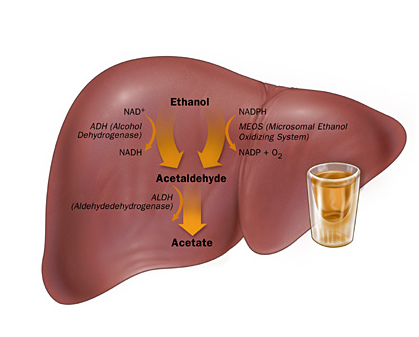Alcoholic Liver Disease
The liver is the second biggest organ in the human body and works through the day and night removing toxins, fighting infections, aiding digestion and lowering cholesterol levels. The over-consumption of alcohol (more than 20 units a week) can cause unnecessary stress to your liver and in long-term, result in Alcoholic Liver Disease (ALD).
Alcoholic liver disease is the result of an overconsumption of alcohol that leads to a buildup of fats and scarring of the liver. It can be fatal.
What is Alcoholic Liver Disease?
Excess amount of alcohol intake for prolonged period may harm liver. Liver disease due to alcohol is known as alcoholic liver disease. This usually manifests in three forms: hepatic steatosis (fatty liver), alcoholic hepatitis and hepatic cirrhosis.
How does alcohol damage liver?
Alcohol is metabolised in liver. During metabolic process there is generation of free radicals and oxidants which damage liver cells and other intracellular organelle. Thus they kill healthy liver cells and produce inflammation. These damaged cells initially become foamy leading to fatty liver, later on fibrosis occurs. Fibrosis might progress to cirrhosis which is irreversible damage to liver. Prolonged cirrhosis is a risk factor for liver cancer. Every patient might not go through every stage.
There are three stages of ALD depending on the intensity of liver damage.
- Fatty Liver:The excess accumulation of fat inside the liver cells is the first step towards ALD. This is a fairly common condition in men and women who are regular drinkers. The condition is preventable and reversible when the alcohol consumption is minimized. Doctors would get an ultrasonography to identify the extent of fatty deposits.
- Alcoholic Hepatitis:This stage includes acute inflammation of liver because of prolonged over-consumption of alcohol. Liver scarring, destruction of individual liver cells and subsequent liver failure are further complications developed. Common symptoms would include jaundice, fever, and enlargement in the liver and an abnormal increase in the white blood cell count. A liver biopsy would reveal how severe the condition is.
- Alcoholic Cirrhosis:The normal liver tissue is completely replaced with scarred, fibrous tissue and regenerative nodules. The regular consumption of more than 60 g of alcohol in men and 20 g of alcohol in women increases the risk of developing acute cirrhosis. The symptoms include portal hypertension excessive bleeding, kidney failure, an enlarged spleen and liver cancer
Following are the treatment aspects of alcoholic liver disease:
- Abstinence::The most important aspect of treatment in ALD is the immediate and total abstinence from alcohol. Drugs may be used to treat the symptoms of withdrawal.
- Good nutrition:: It is critical that the patient’s nutritional intake is adjusted to maintain a high-calorie, high-protein diet. Proteins and vitamin dietary supplements are prescribed. Vitamin B and K are administered. Potassium, magnesium and zinc are administered to those patients with decompensated liver disease.
- Hospitalization:Patients with severe forms of alcoholic liver disease like alcoholic hepatitis or decompensated alcoholic liver cirrhosis with complications may require hospitalization.
- Liver transplantation:Patients with advanced cirrhosis due to alcohol may require because liver transplantation improves survival rates in decompensated liver cirrhosis. However, most transplant centers require a documented period of 6-months of abstinence from alcohol before transplantation
The most important treatment of alcoholic liver disease is complete abstinence from alcohol






